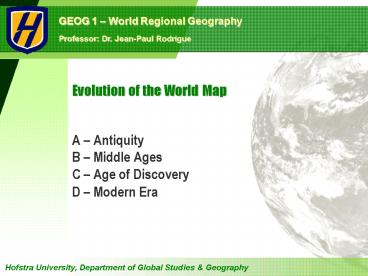Evolution of the World Map - PowerPoint PPT Presentation
1 / 16
Title:
Evolution of the World Map
Description:
Evolution of the World Map. A Antiquity. B Middle Ages. C Age of ... Ptolemy's (150 AD) Ulm edition world map, 1482. Middle Ages. Period of decline ... – PowerPoint PPT presentation
Number of Views:210
Avg rating:3.0/5.0
Title: Evolution of the World Map
1
Evolution of the World Map
- A Antiquity
- B Middle Ages
- C Age of Discovery
- D Modern Era
2
Antiquity
- Herodotus (circa 450 BC)
- Inspired by Pythagoras (530 BC) and his geometry.
- Father of geography.
- Basic physical and human geography.
- Exploration and travel instead of geometry.
- Coined the terms Europe, Asia and Africa (Libya).
Accuracy
Trade route
Distance
Familiar
Accounts
Legends
Terra incognita
3
Herodotus (450 B.C.) (recreation)
4
Antiquity
- Aristotle (circa 350 BC)
- Considered physical elements such as the
temperature and winds as factors of the human
habitat. - Division of the world in 3 climatic zones.
- Relationships between the environment
(temperature) and human habitat. - One of the first physical geographer.
- Judged impossible to cross to torrid equatorial
zone and reach the antipodes.
Frigid
Temperate
Torrid
5
Antiquity
- Eratosthenes (circa 250 BC)
- Formally assumed the earth was round.
- Calculated the circumference of the earth.
- 40,572 km versus the exact figure of 40,091 km.
- Developed the concepts of parallel and meridian.
- Consequently introduced the concept of
geographical location. - Created modern cartography (cartographic plane).
6
Eratosthenes (194 B.C.) (reconstruction)
7
Antiquity
- Ptolemy (circa 150 AD)
- Refined the coordinate system.
- Inventory of population and resources.
- Describing the world.
- 8,000 entries.
- Relationships between the physical and human
elements. - Created map projections.
- His map would remain the most accurate until the
age of discovery.
8
Ptolemy's (150 AD) Ulm edition world map, 1482
9
Middle Ages
- Period of decline
- Cartographic and regional approach was lost in
Europe - Representation of the world was Christianized.
- Orthodoxy replaced objective observation and
analysis. - T and O Maps (Orbis Terrae)
- T is the Mediterranean ( Nile and Black Sea).
- O is the surrounding ocean.
- Greek and Roman knowledge kept by the Byzantine
Empire and by the Arabs.
T-O map from the Etymologiae of Isidorus, 12th
Century
10
St. Sever World Map after Beatus, 1030 AD
11
Age of Discovery
- Exploration and innovation
- The 15th and 16th centuries were characterized by
numerous maritime explorations. - A commercial expansion of European nations.
- Several technical innovations
- The compass, more precise maps.
- Larger ships (they passed from 200 to 600 tons
during the sixteenth century), better ship
structures and the rudder. - Insure a safe, fast and therefore profitable
maritime navigation. - Creation of the first accurate world maps.
12
The Americas, 16th Century
13
World Map, circa 1700
14
Modern Era
- A complete world map
- Early 20th century.
- Complete and accurate view of the world.
- Coordinate systems.
- National inventories of resources.
- Widely available atlases.
- Information technologies
- Use of remote sensing (aerial photographs and
remote sensing). - Digital maps.
- Mass diffusion through online accessibility.
15
Satellite Composite Image
16
A Virtually Navigable World






























